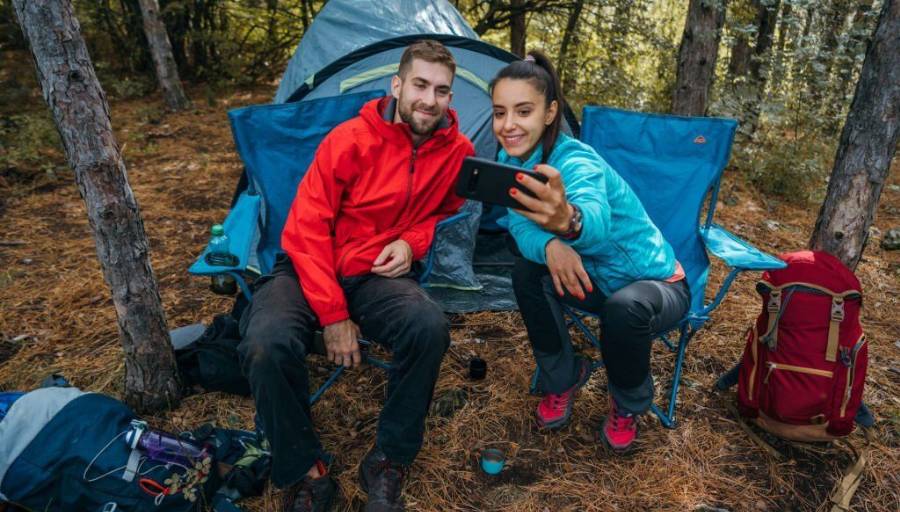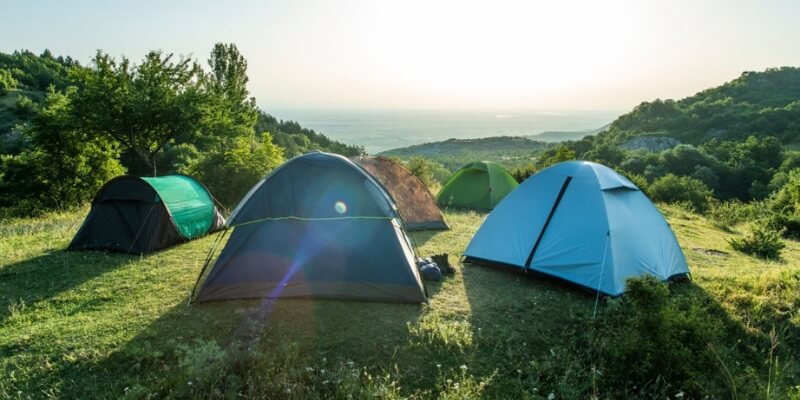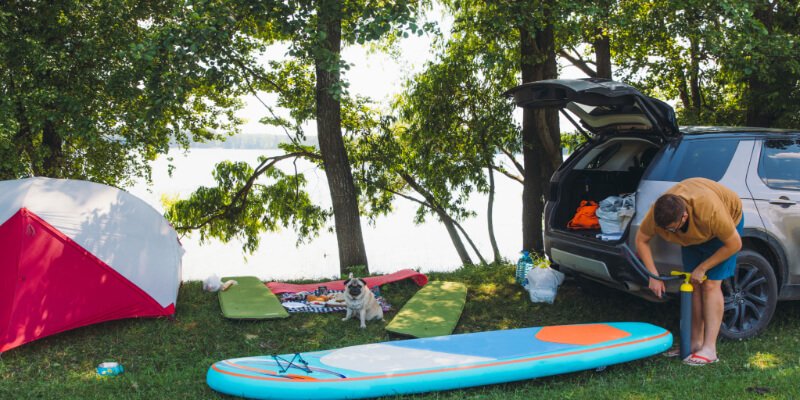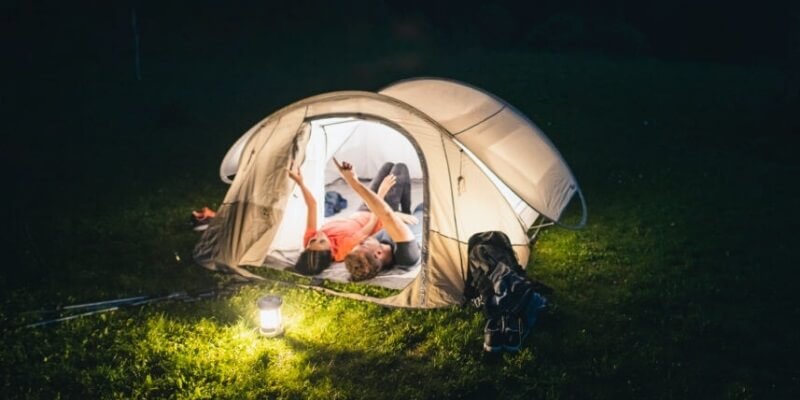Tunnel Tent – Features, Advantages & Disadvantages
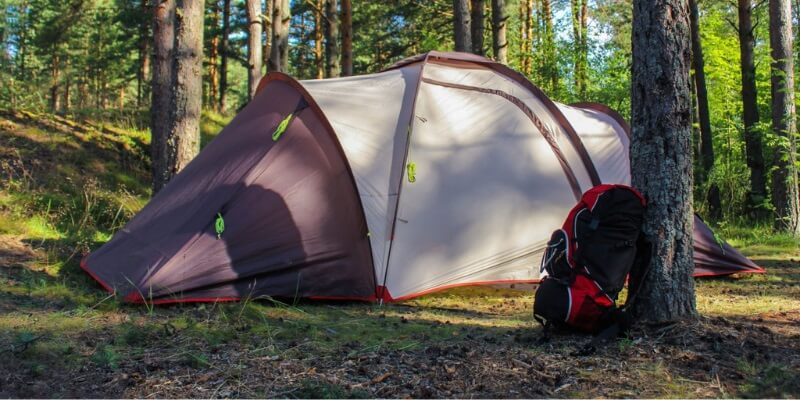
In our detailed guide, we describe what a tunnel tent is and what it is particularly suitable for. We explain the advantages and disadvantages of a tunnel tent, how it performs in the wind, rain & cold, and what equipment a good tunnel tent should have. This post is for anyone who wants to buy a new tunnel tent or just wants to know everything about this type of tent.
What is a tunnel tent?
A tunnel tent is a type of camping shelter characterized by its elongated, tunnel-like shape. It features a curved design and is supported by two or more flexible poles that provide huge living space and headroom. Tunnel tents are known for their stability in windy conditions, as the shape helps deflect strong winds. They often have a spacious interior, making them suitable for families or groups, and usually include a separate vestibule area for storing gear. Their layout allows for efficient use of space. While tunnel tents can be heavier than other types, they offer excellent livability and are popular among backpackers and campers looking for a roomy shelter.
What types of tunnel tents are there?
- Entry-Level Tents: With affordable prices and simple design, these tents fit 3 to 5 people and their gear. These tents are ideal for weekend camping trips and festivals.
- Trekking Tents: Lightweight and compact, these tents are designed for trekking and long hikes, providing space for 1 to 3 people while ensuring durability.
- Family Tents: Family tents can host up to 8 people and include multiple sleeping areas. They often have a weather-protected seating area and can take up to half an hour to set up.
- Inflatable Tents: These tents use air chambers instead of poles, allowing for quick setup with minimal effort. They stand independently when inflated.
- Expedition Tents: Built to withstand extreme weather, these sturdy tents feature ventilation flaps that can be closed from the inside, making them suitable for storms and snow. However, they are smaller and more expensive.
- Hybrid Tunnel Tents: Combining tunnel and other styles, such as dome or cabin tents, hybrid designs offer a unique mix of stability, space, and versatility.
What sizes are tunnel tents available in?
Different sizes of tunnel tents are small enough for 1 person and large enough for 8 people. The smallest tunnel tents are ultra-light. They only weigh around 1 kilogram per person and have a floor area of around 4 square meters. Large tunnel tents on the other hand have a spacious apse and often a height of 2 meters and more. These giants have a footprint of more than 20 square meters.
Tip: You can comfortably stand upright in large tunnel tents. This is not only pleasant when moving in the tent.
How many rooms does a tunnel tent have?
Depending on the size, a tunnel tent has 1 to 4 rooms. There is always a spacious vestibule and a sleeping cabin. In some large tents, the apse can be divided into an open veranda and a (smaller) closed apse by moving the outer wall. Large tents often have several sleeping compartments.
How cozy is a tunnel tent?
Tunnel tents are very cozy compared to other types of tents. They have steep walls. This is why large tunnel tents are around 2 meters high. You can stand comfortably in them. High-quality models also offer numerous functions that make staying inside the tent pleasant. These include darkened sleeping cabins, barrier-free doors, and guides for power cables. The spacious apse allows you to set up chairs, tables, and shelves. You can stay here comfortably in bad weather. In small tent models, it is still possible to sit comfortably.
Tip: The apse of some models can be opened on 3 sides. You can transform the awning into an airy pavilion that offers protection from the sun.
How do you pitch a tunnel tent?

First, set up and tension the outer tent, then hang the inner tent inside. This keeps the inner tent dry during rain. However, the need to secure the tunnel tent with pegs and storm lines—even in good weather—can slow down setup compared to other tents. One person can easily set up small tunnel tents, but large ones are more practical with two people.
Tip: With the right technique, you can also set up large tents on your own: First anchor the head end of the tent in the ground and then pull the tent out like an accordion!
How long does it take to set up?
Attaching storm lines and pegs and hanging the inner tent takes time. A small tunnel tent requires about 5 to 10 minutes to set up, while a large one can take around 30 minutes, mainly for bracing. Tip: If the tent is dry, leave the inner tent in the outer tent when taking it down to speed up the next setup. On calm days, securing just the head and back of your tunnel tent is sufficient.
How well can you sleep in a tunnel tent?
You can sleep comfortably in a tunnel tent due to the steep walls, which provide generous space above your head. Larger tunnel tents often allow for flexible cabin divisions, offering about 1.7 m² of lying space per person—compared to a standard insulation mat’s 1.2 m². Many tunnel tents feature removable partition walls, enabling you to combine cabins into one spacious area if desired. Darkened sleeping cabins enhance morning comfort. Tip: Most people find a lying surface of 2 meters by 0.7 meters sufficient, while children need less space.
How much space is there for luggage?
Even small tunnel tents have an exceptionally large vestibule compared to other tent types, providing plenty of space for your luggage. You can also find additional storage in the gap between the inner and outer tents and in pockets sewn into the inner tent.
Where can you set up a tunnel tent?
A tunnel tent cannot be pitched just anywhere due to the space storm lines require; typically, the setup area should be twice the tent’s width. This makes it challenging to set up in crowded campsites and forests. The tent must be anchored with pegs, but you can also secure it to trees or bushes if necessary. Smooth rock or asphalt does not provide adequate support. For difficult surfaces, you can anchor the tent using rocks or sandbags.
What tools do you need to set up a tunnel tent?
To set up a tunnel tent, you’ll need several tools, including poles for structural support and pegs to secure the tent to the ground. A hammer is the best and safest way to drive the pegs into the earth; using your foot can quickly wear out the soil around the peg. We recommend a relatively heavy and hard hammer with a herring puller, as it can effectively handle solid ground and makes removing the pegs after camping much easier. Storm lines are also essential for added stability in windy conditions.
How stable is a tunnel tent in windy conditions?
A tunnel tent is generally quite stable in windy conditions due to its aerodynamic shape, which helps deflect wind. The design allows for good tension distribution when secured with pegs and storm lines. Additionally, many tunnel tents have a low profile, reducing wind resistance. However, proper setup and anchoring are crucial; failure to secure storm lines or pegs can compromise stability.
How good is the protection from heat?
Many tunnel tents can heat up significantly in the sun due to limited ventilation, often relying on small air inlets in the sleeping compartments. However, well-ventilated tunnel tents remain cooler and feature several entrances for improved air exchange, a large ventilation opening in the sleeping cabin, and an outer tent that doesn’t fully reach the ground to allow cool air to flow in.
What materials are tunnel tents made of?
Tunnel tents are made from nylon, polyester, or canvas. Entry-level tunnel tents usually have fiberglass poles and a PU-coated polyester tarpaulin. This makes them comparatively heavy and not very robust against mechanical loads. High-quality, lightweight backpacking tents are often made with aluminum poles and a silicone-coated nylon tarpaulin. Large family tunnel tents sometimes come with a cotton tarpaulin. They are heavy, but have a pleasant room climate on hot days – cotton is permeable to air.
What about weight & pack size?
Small tunnel tents made of high-quality materials such as aluminum and nylon are therefore very light: They only weigh around 1 kilogram per person and have a pack size of around 3 liters per person. Large tunnel tents on the other hand are often surprisingly heavy.
How expensive are they?
Tunnel tents cost between 50 and 1500 dollars. A beginner tent for 4 people, sufficient for occasional camping in good weather on the campsite, is available for around 100 dollars. Large family tunnel tents cost two to three times as much, and a sturdy cotton tent for 6 people can cost 800 dollars. The most expensive are robust expedition tents which cost more than 1000 dollars.
Which tunnel tents are recommended?
There are many excellent tunnel tent models suitable for various purposes. Here are three tents that we recommend as particularly commendable in their application areas:
Entry-level: The Campfire 4-person tent
The CampFeuer 4-person tent (current price on Amazon) is an inexpensive but well-constructed tent with mosquito nets on the sleeping cabin and plenty of space for luggage in the large anteroom.
What we like a lot
The low price and sensible layout make this tent good for beginners: it is available for around 100 dollars. Thanks to its exemplary ventilation through 3 entrances and a window, the tunnel stays pleasantly cool in summer. The anteroom is spacious and offers enough space for bulky luggage such as camping furniture and cool boxes.
What we don’t like so much
There is some room for improvement in bad weather protection. The 3000 mm column and sealed seams are waterproof. However, awning walls are not pulled down to the ground: In strong winds and rain, luggage can get wet in the edge areas. The enclosed pegs serve their purpose but should be replaced with better models when camping regularly.
Vango Odyssey Air 800 Tent
Family tent: Vango Odyssey Air 800
The Odyssey Air 800 from Scottish manufacturer Vango features air tubes instead of classic rods. It has 5 rooms and a total usable interior area of 18.09 m² – plenty of space for up to 8 people. There are 2 sleeping cabins on the left and right of the tent. The middle of the tent serves as a living area.
We like that very much
The tent is very spacious. When fully occupied by 8 people, each person has 2.26 m² of space. In the living area, you can stand and even set up a small group of seats. The outer walls completely reach the covered floor all around. The sleeping compartments have a second, sewn floor. Therefore, the tent is suitable for cold and wet weather. Thanks to air technology, you can set up within 20 minutes without second-person help.
We don’t like that very much
While the ventilation of the living area through the two opposite entrances works well, the ventilation of the sleeping compartments is not optimal on hot summer days: There are only a few relatively small ventilation openings. This is why it can get warm in sleeping cabins between sunrise and sunset.
Trekking tent: Coleman Cobra 3
When carrying tents over longer distances, whether on a hike or traveling by train to a festival, weight is crucial. The Coleman Cobra 3, designed for three people, weighs just 2.9 kg and has a compact pack size of 20.5 liters, making it an excellent choice for those prioritizing portability without sacrificing comfort.
We like that very much
The tent is incredibly light – it weighs less than 1 kilogram per person. The interior space is truly big. In addition, there are 2 generous vestibules on the sides for luggage. A water column of 3000 mm for the outer tent and 5000 mm for the ground means it stays dry inside even with prolonged rain. The price-performance ratio is excellent.
We don’t like that so much
As with many other tents, we also complain here: the ventilation could be better. We don’t apprehend why the inner door only has a mosquito net on a small ventilation opening. The supplied pegs also seem unstable.
Final Thoughts
A tunnel tent is a versatile and reliable shelter in various environments. Its unique design, with arched poles creating a tunnel-like structure, offers a range of features and benefits. Its easy setup, stability in adverse weather conditions, and a range of specialized designs are ready to serve diverse camping needs. However, it’s important to consider potential drawbacks such as requiring secure staking in windy conditions.
Thanks for reading. If you have any questions, ask in the comment section below.




